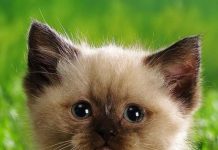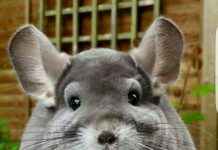The Irish Wolfhound is a dog that is hard to forget when you see it once. The stone castles of the Irish counts and the hunt for ferocious wolves with huge dogs come up in the imagination. This rare breed these days is not trained for hunting. The dog is chosen as a faithful companion and devoted friend with a kind and courageous character.
Material Content:
Description of the breed Irish Wolfhound
This is one of the largest dogs in the world. She looks more like a little pony than a dog, and standing on her hind legs, she can easily put her face on the head of the owner.
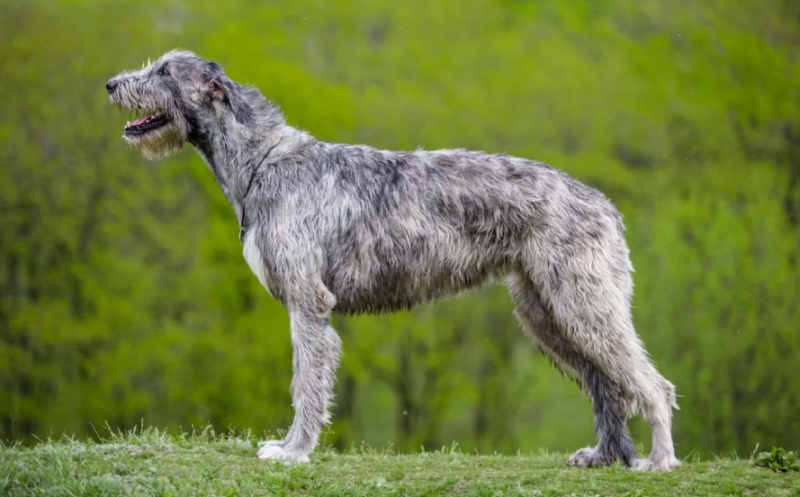
Despite the awesome name and impressive size - it is the kindest breed, calm and obedient. It frightens the hostile enemies not with a formidable grin of teeth, but with an impressive appearance. If he is in danger, he will always come to the rescue.
A dog an Irish wolfhound will never begin to bark for nothing, it rarely gives voice. Her movements are calm and graceful, a vibrant mind is visible in dark eyes.
History of breed origin
The history of the breed dates back many centuries. Back in the 1st century BC e. Wolfhounds brought to Ireland by the Celts. Dogs were used in hunting, in combat battles and for the protection of fortresses.
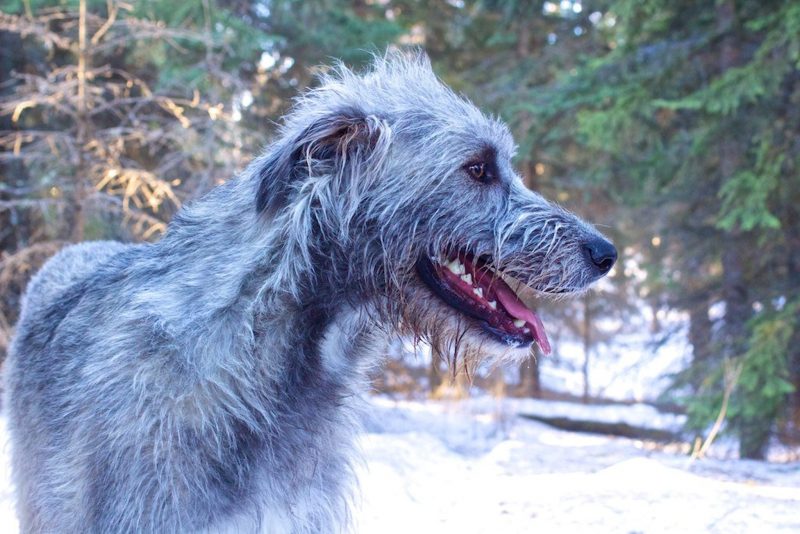
The second name of the breed is Irish Greyhound. Dogs chasing moving game. The hunting instinct is preserved in modern wolfhounds, they can break loose after seeing a cat running through.
Dogs taken out in the 1st century BC e. to Scotland, are the ancestors of the Scottish Dirhounds. In the Middle Ages, every Irish county was required to contain about 2 dozen wolfhounds to protect livestock and people from wolves.
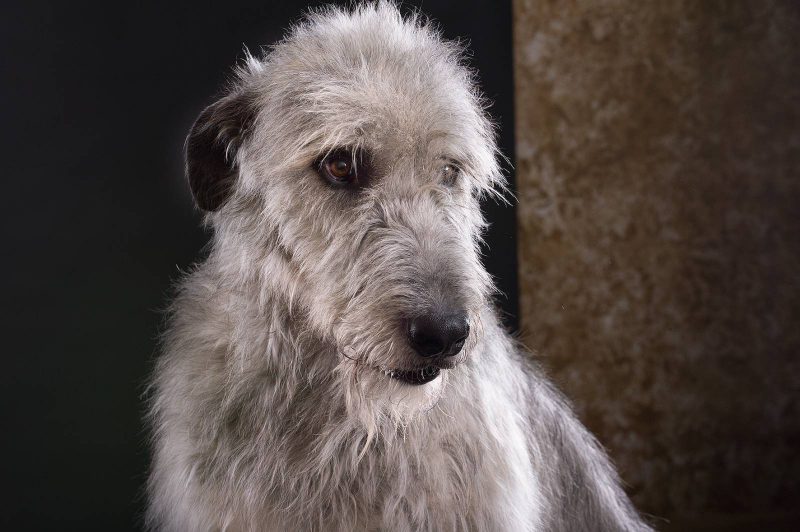
By the end of the XVII century, wolves were exterminated, dogs were left without work, they began to be actively exported to other countries. The breed was endangered. Its revival began only at the end of the 19th century.
Purpose and character
The four-legged friend is very good-naturedly disposed towards people and other animals, there is no aggression in him. Currently, a dog is more of a companion than a hunter.
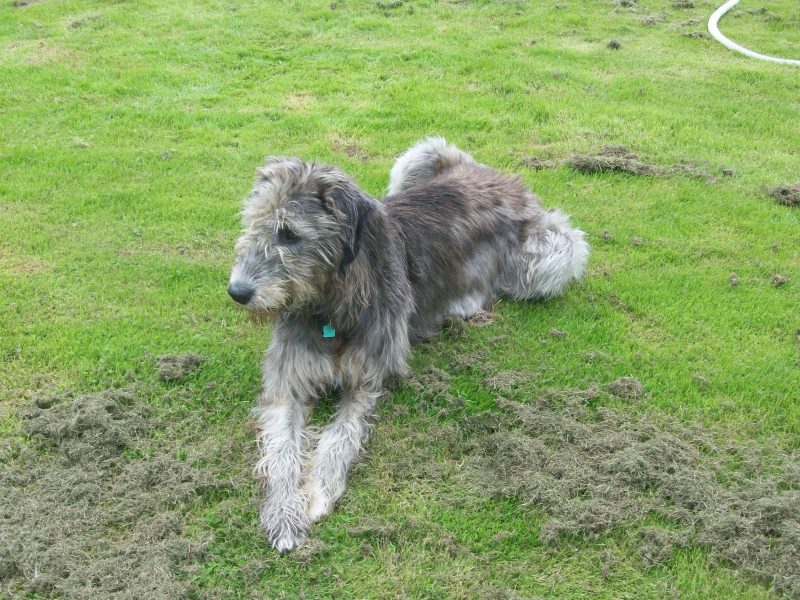
This does not exclude the use of representatives of the breed for hunting after undergoing special training. Various sports are currently popular with the participation of Irish Wolfhounds. They have no equal in running speed, they easily overtake galloping horses.
A characteristic of the character of the dog, which cannot be ignored, is a strong attachment to the owner. Short-term separation can lead to illness and even death of the pet. A highly developed hunting instinct sometimes causes the wolfhound to pursue other domestic animals that were not raised with him from puppyhood. A guilty dog cannot be beaten and shouted at him; he is very touchy and impressive. He will not take revenge, he will go to his corner, and may get sick.
Breed standard
The appearance of an Irish wolfhound is similar to a deerhound. This is not surprising, since the blood of this breed flows in his veins. With a huge size, the dog is muscular, it is unusual for her to gain excess weight. She looks elegant, moves freely and gracefully.
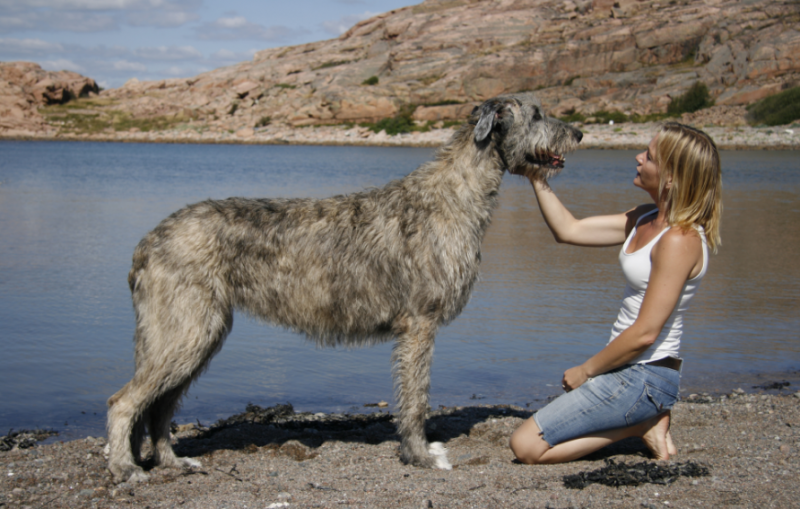
The requirements of the standard for appearance and temperament:
- muzzle is long, slightly narrowed;
- eyes are dark;
- small ears;
- slender, muscular neck;
- elongated body;
- the loin is convex;
- chest wide, belly tightened;
- the tail is long, curved, covered with wool;
- paws are bony, straight, with muscular forearms and hips;
- the coat is coarse and stiff, especially above the eyes and under the muzzle;
- any color found at the dirhound is acceptable;
- height at the withers of males from 80 cm, females 10 cm lower;
- the weight of dogs from 55 kg, from bitches from 40 kg;
- temper calm and balanced at home, fearless - on the hunt.
The disadvantage of the breed in appearance is the color of the nose and lips of any other color than black, light eyes and pink eyelids. There should be no deviations in the proportions of the body. Disadvantages of temperament - cowardice and aggression are rare, they can be seen even in puppyhood.
Puppy selection criteria
Irish Wolfhound puppies are sold in kennels, rarely from private owners. In order to insure yourself against an inadequate or sick pet, it is advisable not to save on purchase, and go to the nursery.
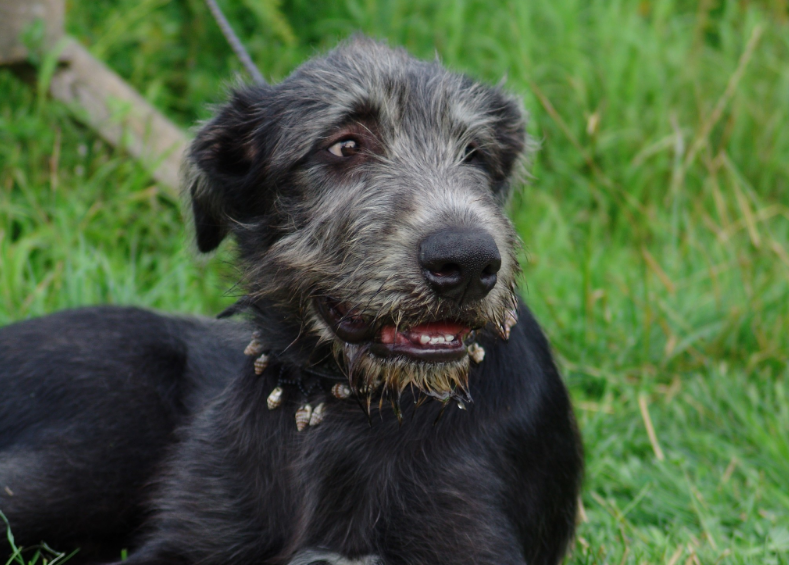
The breeder must ask for documents confirming the health of the baby, his vaccinations. Be sure to get acquainted with the parents of the dog, and see the conditions of detention.
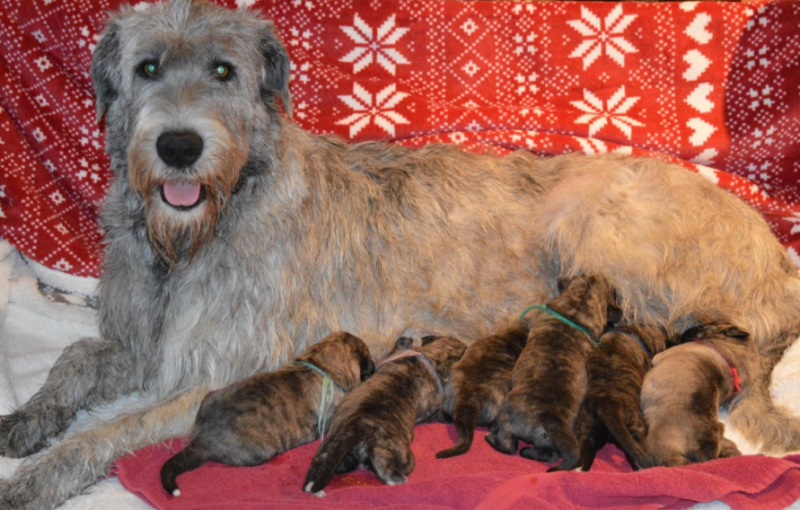
The puppy should be lively, agile, curious, with shiny, smart eyes, clean hair. For a show pet, the appearance of the breed must be consistent with the standard.
Keeping and caring for a dog
Feeding the Irish Wolfhound is best with super-premium dry food. A dog needs high-calorie food, but you can’t overfeed it. For an adult wolfhound, 600–700 g of dry food per day is sufficient. When feeding natural food, meat and vitamin-mineral supplements must be present in the daily diet.
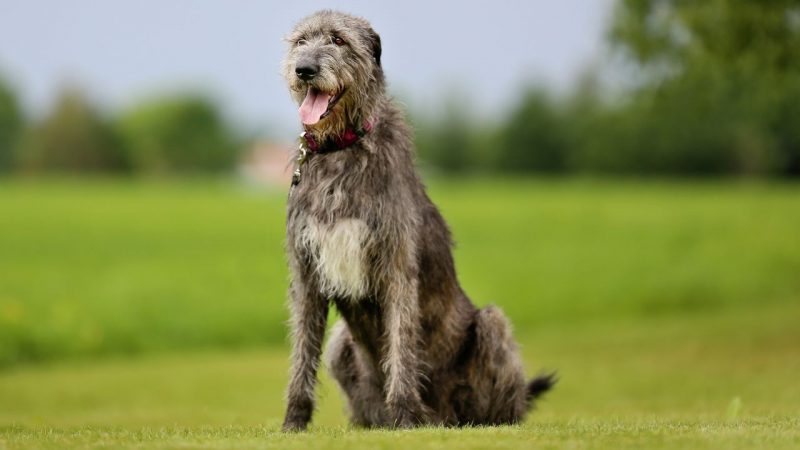
A growing young dog needs more food, about 1 kg of dry food per day, it is given in 3-4 doses. Kids add a little water to the dry granules. In addition to dry food, cottage cheese, fruits, vegetables are useful. An adult dog is fed 2 times a day. Drinking water is changed daily.

The dog needs to be combed out and bathed 1 time in 10 days. This is a wire-haired breed that almost does not fade, there is no unpleasant odor from it. For a country dog, bathing once a month is enough, with a special shampoo caring for the coat.From puppyhood, the pet is also taught to trim their nails, trim, and care for their ears and teeth.
How to train and educate
The breed belongs to the greyhounds, it runs very quickly, responds well to moving prey. Running speed reaches 60 km. An untrained dog can run for a walk on the cat and the owner will be powerless to do something.

For a growing wolfhound puppy, it is important to spend a lot of time in nature in order to move freely. Dogs grow for a long time, up to about 2 years. For an adult dog, the limited space of a city apartment is quite suitable. There are special sports competitions for wolfhounds, for example, coursing. Training in sports disciplines is carried out regularly after a year, when the dog’s backbone gets stronger. Trainings in running and obedience to teams begin from 6 months.
When training an Irish wolfhound, one must take into account his melancholic, calm temperament and strong touchiness. Commands cannot be given in a raised tone. The dog will perceive the scream as a manifestation of weakness, and will not obey.
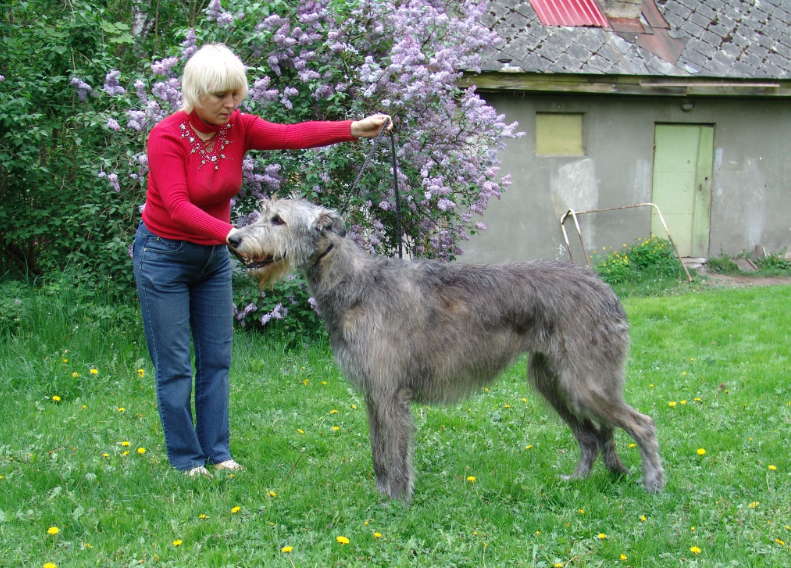
If the puppy lives in a city apartment, he needs to be led out for a walk in busy city parks. The pet will be able to get used to the hustle and bustle of the city, it will not be frightened by external irritants during a walk.
Pros and cons of the breed
The average life expectancy of an Irish wolfhound is 8–10 years; 12-year-old dogs are considered long-livers. They are prone to diseases of the heart, joints, gastrointestinal tract. Poor health is the main disadvantage of the breed. Puppies grow up for a long time, reaching full prosperity only after 2 years of age.

The undoubted advantages include a kind, flexible character. The dog treats children well. She calmly reacts to their pranks, suffers even unintentionally caused pain. Never growls at the child, regardless of whether it is a bitch or a dog. This breed is completely averse to aggression, puppies willingly flock to strangers.
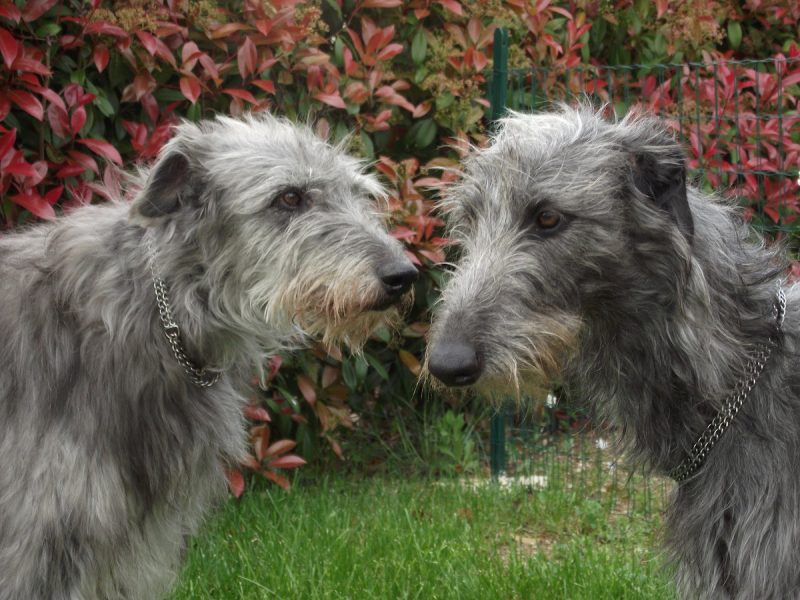
The giant growth of the Irish Wolfhound is more a virtue than a disadvantage. For keeping a large pet, a country house or castle is better than a small city apartment.
How much is an Irish Wolfhound dog
An elite puppy of an Irish wolfhound costs from 1.5 thousand euros and above. Breeding a breed is very difficult, it has hereditary diseases, many representatives are rejected from breeding.
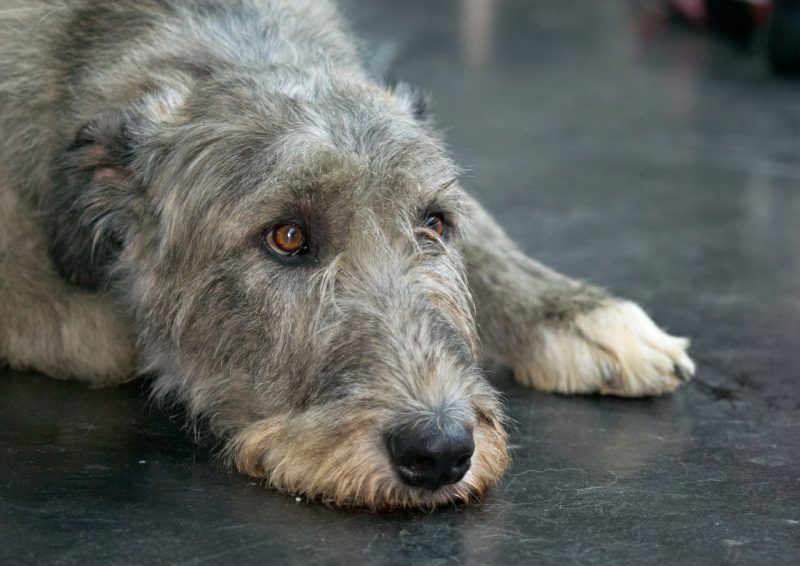
The dog grows up for a long time, bitches begin to give birth only at three years of age, their child-bearing age is short. In one litter there can be from 2 to 12 puppies. The breed is not very popular in Russia, so such a high price for puppies.
A pair of Irish wolfhounds in ancient times was the best gift for the royal families of Europe. Now the breed has become a national treasure of Ireland, it is willingly bred by wealthy people around the world. Having such a friend, it is not scary to walk along the dark streets of the city and in the shady protected forest.



